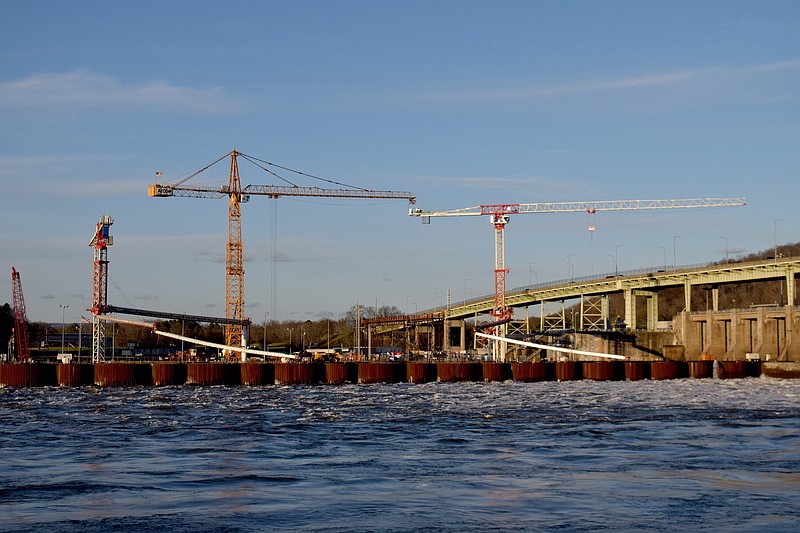For the next decade, U.S. taxpayers will pick up a bigger share of paying for upgrades and maintenance of America's inland locks and dams, including the ongoing work on one of Chattanooga's biggest construction projects at the Chickamauga Dam.
Under an omnibus spending bill approved by the House and Senate and now headed to President Trump for his final signature, the share of costs borne by taxpayers for construction and major rehabilitation of inland waterway projects will grow from 50% to 65% through fiscal 2031.
Historically, the costs of major lock and river navigation projects by the Corps have been split evenly between federal funds and taxes on the barges that use such locks. But under such a formula even with an increase in the barge fuel tax five years ago, the Inland Waterways Trust Fund has shrunk to only about $43 million of reserves and there isn't enough money to finish all of the projects that have been authorized to be built.
The funding package adopted this week in Congress also increases funding for the Army Corps of Engineers, which operates most locks and dams, to a record high of nearly $7.8 billion.
"This is a win for the nation, our economy, and shippers and exporters," said Tracy Zea, president of the Waterways Council Inc., a trade group that represents the barge industry. "An efficient, modern inland waterways system facilitates U.S. competitiveness in world markets, and this bill's passage will strengthen our ability to stay on top."
Outgoing Tennessee Sen. Lamar Alexander, who has battled to get and sustain funding for the replacement lock at the Chickamauga Dam throughout his 18 years in the U.S. Senate, said the new spending measure should ensure continued work on the building of the new and bigger Chickamauga Lock.
Over more than a decade, the Corps has already spent $318 million on preparing and building the initial phases of the new lock, but that represents only about 42% of the estimated $757 million total costs of the new Chickamauga Lock.
The cost of the project has nearly doubled from when it began nearly a decade and a half ago, in part, because of delays and interruptions in the funding stream for the project.
A 110-by-600-foot lock is being erected beneath the Chickamauga Dam to replace the current, smaller lock to allow tow boats to more efficiently push more and bigger barges through the lock at one time. The existing lock at the Chickamauga Dam was built by Tennessee Valley Authority in 1940 and later taken over by the Corps after it developed problems with concrete growth and the lock walls began to crumble.
With adequate funding, the Corps has estimated the new lock could be completed by 2024.
"This is great news for East Tennessee since the new lock will help keep up to 150,000 trucks off I-75 and keep the cost of shipping goods low for manufacturers across the state," Alexander said.
U.S. Rep. Chuck Fleischmann, a member of the House Appropriations Committee who helped push through the higher funding for the Corps as well as funding for a host of projects at the Department of Energy's Oak Ridge reservation and a new federal courthouse in Chattanooga, said the new spending plan ensures that work will continue on the new lock at the Chickamauga Dam.
"From the Chickamauga Lock, to the Oak Ridge Reservation, and the Chattanooga Federal courthouse I will never cease fighting for East Tennessee's priorities," Fleischmann said.
In the next two to three months, the Corps will develop its specific spending budget for each of its projects in fiscal 2021, but the Corps has already projected the efficient funding level for the current fiscal year at the Chickamauga Lock project should be $60.4 million, according to Adam Walker, the project manager at the Corps of Engineers.
The new funding formula is expected to provide more than $1 billion in additional construction funds over the next decade to reduce the backlog of authorized, but unfunded civil works projects by the Corps, Zea said.
Contact Dave Flessner at dflessner@timesfreepress.com or at 423-757-6340.
